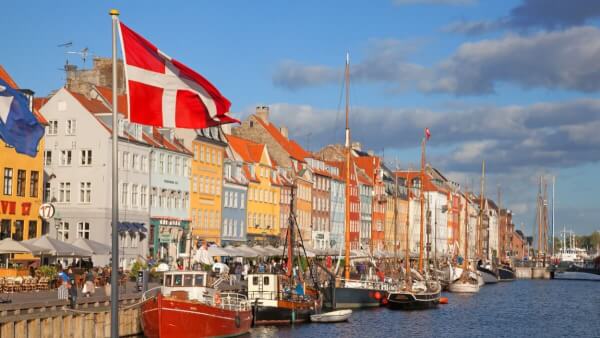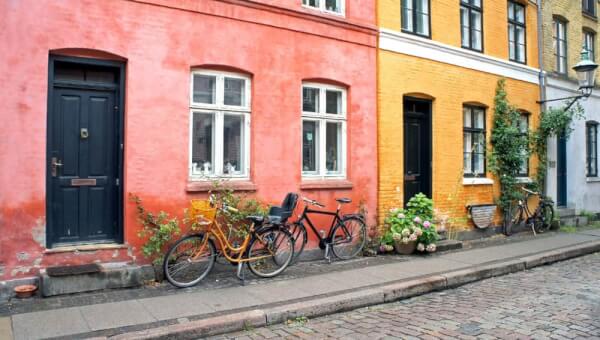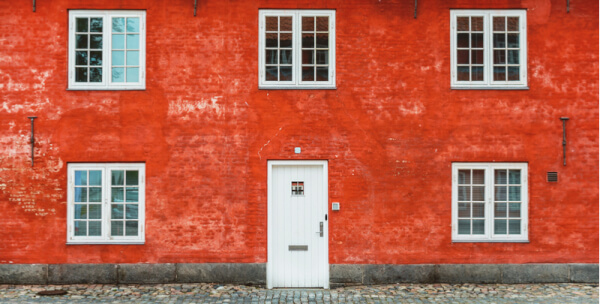A list of the top banks in Denmark
A list of the top banks in Denmark, including Danske Bank, Nykredit, Nordea Denmark, Jyske Bank and many more.

Denmark is known for its high standard of living, enticing mix of calm natural environments and buzzing cities, and a great work-life balance. In fact, in the World Happiness Report, which has been produced annually since 2013, Denmark has featured in the top 10 every time¹. It’s no surprise that many expats are drawn to Denmark as an exciting place to live, work or study.
Whether you’re retiring, temporarily relocating, or moving there for good, you’ll want to know a bit about the cost of living in Denmark so you can plan and budget. This guide has you covered. We’ll also explain how you can make your money go further with a smart multi-currency account from Wise.
The official money in Denmark is the Danish kroner - shown as DKK. Here’s what the kroner is currently worth against other major world currencies. The value of currencies changes all the time - so use a currency converter or Google search to find the live rates for your currency pairing.
$1,000 = DKK 7,163
£1,000 = DKK 8,166
€1,000 = DKK 7,436
A$1,000 = DKK 4,827
The values of DKK compared to other world currencies shown above use the mid-market exchange rate. That’s the rate banks and other currency providers get when they buy foreign currency themselves.
However, it’s good to know that this is not often the exchange rate they make available for their customers. Instead, banks and exchange services typically add a markup or margin to the exchange rates offered - which pushes up the price. This markup is an extra fee but it’s not always obvious and makes it tricky to see the true cost of your currency exchange.
To see this in action, compare the exchange rate offered by your chosen provider against the mid-market rate which you can find using a reputable currency converter. The difference between the rates represents the markup - or additional charge - added by the provider.
It’s common for banks and currency exchange services to add a hidden fee on the exchange rate offered to customers. But there are services out there which prefer to use the mid-market rate with a transparent fee structure, like Wise.
With Wise you can open a multi-currency account for free, to hold and manage 40+ currencies, and send payments to 160+ countries. You’ll be able to switch between currencies whenever you need to, using the mid-market exchange rate with no markup, and for just a low transparent fee*.
Sign up online today, and get your linked debit card for simple spending. It’s never been easier or cheaper to manage your money across currencies.
Life in Denmark isn’t cheap. However, as with many places, costs vary depending on your lifestyle and where in particular you choose to live. Copenhagen is the only Danish city which features in the top 100 of the Mercer’s Cost of Living index in 2022 - the 11th most expensive place on the planet to call home.²
Here’s a quick overview of the costs of living in Denmark compared to some major UK cities.
| Comparing basic cost of living | 1 bedroom flat in city centre (monthly rent) | Meal for 2 (mid-range restaurant, three courses) | Transportation (monthly pass) |
|---|---|---|---|
| London, UK⁴ | DKK 16,693 | DKK 579 | DKK 1,296 |
| Manchester, UK⁴ | DKK 7,985 | DKK 518 | DKK 604 |
| Edinburgh, UK⁴ | DKK 7,839 | DKK 507 | DKK 507 |
| Copenhagen, Denmark⁴ | DKK 12,058 | DKK 793 | DKK |
| Aarhus, Denmark⁴ | DKK 7,442 | DKK 644 | DKK 396 |
| Aalborg, Denmark⁴ | DKK 5,452 | DKK 644 | DKK 396 |
*Live data from Numbeo, correct at time of research 25 November 2022
As the capital, and largest city by far, Copenhagen is a natural draw for expats moving to Denmark.
However, there are some other exciting places to consider, where the costs of living may be somewhat lower. Aarhus - also written Arhus - for example, is Denmark’s second city by size of population, and offers great cultural attractions on the east coast of the Jutland peninsula.
Other notable places to consider include Odense and Aalborg.
Here’s an insight into the costs for different family sizes - including the necessary household utilities - in the 2 biggest cities in Denmark.
| Total living expenses in Copenhagen | Average cost⁵ |
|---|---|
| 1 person, per month (without rent) | DKK 7,751 |
| 4 person family, per month (without rent) | DKK 27,961 |
| Utilities, basic, for 85m² apartment | DKK 1,408 |
| Total living expenses in Aarhus | Average cost⁶ |
|---|---|
| 1 person, per month (without rent) | DKK 7167 |
| 4 person family, per month (without rent) | DKK 25,877 |
| Utilities, basic, for 85m² apartment | DKK 1,280 |
While the costs of life in Denmark are on the high side, this is reflected in extremely healthy average salaries.
To give an example, if you’re a receptionist in Aarhus, earning a median salary, you could be among the highest paid people in the world for your job⁸. Similarly, the median salaries for architects, fashion designers and financial analysts also rank within the top 3 globally in Aarhus⁸.
Check out the average salaries for your profession, using data from Teleport:
| Salary averages for Copenhagen⁷ | Average salary |
|---|---|
| Mobile developer | DKK 747,449 |
| Accountant | DKK 594,697 |
| Project Manager | DKK 584,844 |
| Office Manager | DKK 558,695 |
| Administrative Assistant | DKK 510,838 |
| Attorney | DKK 493,792 |
| Salary averages for Aarhus⁸ | Average salary |
|---|---|
| Mobile developer | DKK 669,146 |
| Accountant | DKK 527,377 |
| Project Manager | DKK 460,293 |
| Office Manager | DKK 495,451 |
| Administrative Assistant | DKK 448,774 |
| Attorney | DKK 455,059 |
Living in a major city will usually be significantly more costly than choosing a rural retreat - and Denmark is no exception.
You’ll find some average costs for apartments in Denmark’s major cities below - but you’ll find your money goes further if you are able to live a little out of the city centre, or if you choose a smaller town as a base.
| Rental cost in Copenhagen⁹ | Average monthly cost |
|---|---|
| Large apartment | DKK 16,445 |
| Medium apartment | DKK 12,155 |
| Small apartment | DKK 8,580 |
| Rental cost in Aarhus⁹ | Average monthly cost |
|---|---|
| Large apartment | DKK 12,155 |
| Medium apartment | DKK 9,295 |
| Small apartment | DKK 6,006 |
Denmark has a comprehensive health system including both public and private services. If you’re working in Denmark you’ll be entitled to public health cover, which means free care at doctors surgeries and in hospitals.
However, you will need to pay for dental care, and between 25% and 50% of the cost of prescription medications.¹⁰
It’s also possible to use private healthcare facilities or buy private insurance if you’d prefer.
The Danish government describes Denmark as a ‘country of cyclists’. There are actually 4.5 million bikes in Denmark - which works out at almost one per person living there.¹¹
This all means that there are great facilities for commuters who want to cycle, walk or use public transport. In large cities like Copenhagen you’ll be able to use local trains, metro or buses, and there are good connections to even the most rural of areas.
Most of the road network is free to use if you prefer to drive, although there are some tolls and traffic in cities can be heavy during peak times.
Denmark is a relatively small country, and it is well connected with trains, buses, ferries and internal flights. Getting around for work or leisure should pose no problem.
Denmark has high quality education throughout, including some great universities for higher level study. The University of Copenhagen comes in at 39th in the world rankings of universities for 2022.¹²
Studying at a university in Denmark is free for students from the EU, those holding a permanent residence permit, a temporary permit which can be changed to permanent, or those from outside of the EU who have a parent already working in Denmark.
If you’re not eligible for free university education, the fees will vary according to the course and institution you choose. To give you an idea, the approximate cost for a full time degree is between DKK 57,202 and 150,156.¹³
Life in Denmark is attractive - but certainly not cheap. If you’re moving there, it makes good sense to plan your budget in advance, and cut costs where you can.
One smart way to avoid paying excess bank fees is to use a Wise multi-currency account to send, spend and receive money internationally.
Get yourself a Wise account today, to see how much you can save.
Sources:
All sources checked on 25 November 2022
*Please see terms of use and product availability for your region or visit Wise fees and pricing for the most up to date pricing and fee information.
This publication is provided for general information purposes and does not constitute legal, tax or other professional advice from Wise Payments Limited or its subsidiaries and its affiliates, and it is not intended as a substitute for obtaining advice from a financial advisor or any other professional.
We make no representations, warranties or guarantees, whether expressed or implied, that the content in the publication is accurate, complete or up to date.

A list of the top banks in Denmark, including Danske Bank, Nykredit, Nordea Denmark, Jyske Bank and many more.

Are you wondering how to buy a summer house in Denmark? We’ve got you covered with our detailed guide.

Your essential guide on how to buy property in Denmark as a foreigner. Learn about house prices, legal requirements, mortgages and more.

People dream of moving to Denmark for its egalitarian society, progressive ideals and focus on design and aesthetics. In Denmark, you’ll find bakeries,...

Copenhagen is a world class city, with fantastic culture and a vibrant cosmopolitan outlook. The Danes are famed for having the best work life balance on the...

Between insanely beautiful nature and architecture, one of the highest happiness indexes in the world, incredible workers’ benefits and the unique (and cozy!)...